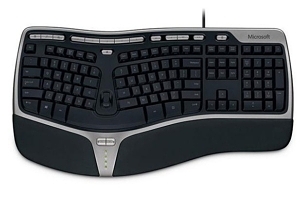

- MICROSOFT ERGONOMIC KEYBOARD 4000 REVIEW MAC OS X
- MICROSOFT ERGONOMIC KEYBOARD 4000 REVIEW PRO
- MICROSOFT ERGONOMIC KEYBOARD 4000 REVIEW WINDOWS
Another common criticism of the Elite is that the arrow keys' inverted-T layout has been changed into a cross-like layout, with left/right arrows keys side by side and up/down keys bracketing them from above and below, increasing the distance between the vertical keys.

The Elite features a nonstandard layout of the six-key navigation/edit key cluster normally found above the cursor keys ( Ins/ Del, Home/ End, and PgUp/ PgDn). Like the original Natural Keyboard, the Elite was manufactured by Key Tronic, who also assisted in its development. The first of these was the Natural Keyboard Elite, introduced in February 1998 at a retail price of US$64.95 (equivalent to $103 in 2020). The Microsoft Natural Keyboard has had several upgrades and refreshes since its introduction.
MICROSOFT ERGONOMIC KEYBOARD 4000 REVIEW MAC OS X
Īs with most Microsoft keyboards, software (Microsoft IntelliType) is bundled with the keyboard for both Mac OS X and Windows, allowing users to customize the function keys and modify keys fairly extensively.

Over 3 million units had been sold by February 1998, when its successor, the Natural Keyboard Elite, was introduced. Microsoft soon asked Key Tronic to ramp up production to 100,000 per month in 1995, and the Natural Keyboard sold over 600,000 per month at its peak. The keyboard gained popularity quickly, exceeding Microsoft's forecast of 100,000 units sold by the end of 1994. The three Num Lock/Caps Lock/Scroll Lock status lights are arranged vertically between the two halves of the alphanumeric section.Īlthough it was not the first ergonomic keyboard, it was the first widely available sub-$100 offering.
MICROSOFT ERGONOMIC KEYBOARD 4000 REVIEW WINDOWS
This keyboard also introduced three new keys purposed for Microsoft's upcoming operating system: two Windows logo keys ( ⊞ Win) between the Ctrl and Alt keys on each side, and a ≣ Menu key between the right Windows and Ctrl keys. Another innovation was the integrated wrist pad helping to ensure correct posture while sitting at the computer and further reducing strain on the neck, arms and wrists. This key arrangement was ergonomically designed to prevent carpal tunnel syndrome and other repetitive strain injuries associated with typing for long periods of time. The keyboard uses a fixed-split design, with each half of the alphanumeric section separated, laterally rotated, and tilted upwards and down from the center of the keyboard. The Microswitch division of Honeywell, which was responsible for that company's keyboards and was acquired by Key Tronic in early 1994, is also credited with design input. It was designed for Microsoft by Ziba Design with assistance and manufacturing by Key Tronic. The first generation of the Microsoft ergonomic keyboards, named the Natural Keyboard, was released in September 1994, designed for Microsoft Windows 95 and Novell Netware. ^ Adds 15 hot keys PrtScrn and additional Delete added to the end of F1– F12 row numpad features = in place of Num Lock and additional row on top: Clear, (, ) and ← Backspace right ⊞ Win and ≣ Menu are replaced with Office and ☺.^ Adds 4 hot keys including Calculator above numpad PrtScrn and additional Delete added to the end of F1– F12 row numpad features Clear in place of Num Lock.^ a b Media related functions are integrated via F-lock on F1- F12.^ Nonstandard 2-column, 4-row layout columns (from left to right) are Del (double height Del)/ Ins and Home/ End/ PgUp/ PgDn.^ Separate number pad integrates Clear in place of Num Lock and has additional 3-button row on top: Num Lock, Calculator, and ← Backspace Calculator dublicaded on main unit.^ Adds 16 hot keys =, (, ) and ← Backspace duplicated above numpad.Ins moved to PrtScrn as the secondary function activated by F-Lock ^ Nonstandard 2-column, 3-row layout columns (from left to right) are Home/ Del (double height Del) and End/ PgUp/ PgDn.

^ Adds 17 hot keys Ins integrated with Print Screen.
MICROSOFT ERGONOMIC KEYBOARD 4000 REVIEW PRO


 0 kommentar(er)
0 kommentar(er)
